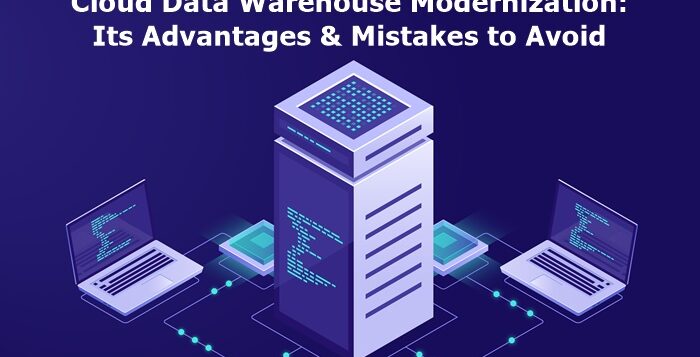What Is Cloud Data Warehouse Modernization
Cloud Data Warehouse Modernization is the process that enables the data warehouse environment to meet the quickly changing business requirements steadily. The cloud data warehouse is ever-evolving. This makes data warehouse optimization critical to ensure enterprises have timely access to data and analytics. Cloud Data Warehouse Modernization provides support for new data sources and makes way for new solutions.
Advantages of Cloud Data Warehouse Modernization, Hybrid Cloud Architecture Adoption
Hybrid Cloud Architecture Adoption Delivers Operational Efficiency
Managing one extensive database is more straightforward than managing multiple smaller ones. Hybrid storage is a more scalable model ever devised in this matter. It combines cloud storage and on-prem object storage. This provides data transparency and simplifies management. Hybrid Cloud Architecture can track data that has any point of origination or storage. Hybrid keeps all metadata on-premises, cause ease of search on Cloud and on-premises, both.
Access to a Widely Accepted Standard Interface
The acceptance of a standard interface for on-premises and cloud storage has changed everything. The standard interface ensures to cut down on costs and provide inter-operability. S3 API is the standard for hybrid storage, an interface that began in cloud storage. S3API is now available for on-premises object storage too. Amazon, Google, and Microsoft all rely on object storage for their cloud infrastructure. This interface standardization is essential because it gives the managers the ability to use standard tools on-premises and in the Cloud. This standardization also makes it easier to move data between the two environments. This optimizes the cost, performance, and durability of the data.
More Deployment Options According to Your Need
Every organization has different storage needs, and they need operational flexibility to address them. Organizations can select from options that have zero upfront cost to systems of immense storage and value. There are multiple offerings to meet both short-term and long-term cloud storage needs. Across both on-prem and Cloud, a standard interface lets you test the optimal solution. Both rapid data access and long-term archival storage requirements can be achieved with a standard set of tools and techniques.
Highest Quality Data Protection is Available for Everyone
Data protection is the most important aspect for storage. A hybrid storage model offers much better data protection to businesses of all sizes. Previously, only companies of high value were able to afford such data protection. Hybrid storage provides incredible data durability. A hybrid storage model allows you to have a copy of data on-site for quick recovery and off-site data for fast disaster recovery. Off-site data is low-cost and a long-term archive. Popular backup solutions such as Veritas, Commvault, and Rubrik provide Amazon S3 connectors. These S3 connectors enable this solution as a drop-in.
Hybrid Data and Data Governance Rules
There are both internal and external data governance rules that play a big part in data storage planning.When surveyed, 60% of respondents stated that they need to keep some amount of data on-premise. More than half of them said that only half their data could be uploaded on the Cloud. Internal and external governance have a significant impact on how sensitive data such as personal information and financial data is stored. With a hybrid cloud model, these variations can be easily managed. A hybrid data model helps you to tailor the migration and data protection rules.
Mistakes to Avoid In Cloud Data Warehouse Modernization Design
Focusing Entirely on Current Business Needs
Investments made in the data warehouse design are most fruitful in the long term. Short-term returns are not guaranteed. Therefore, focusing on current business needs would be wrong. In an ideal situation, A five-year roadmap of the organization should be considered when creating a data warehouse design in an ideal situation. Attention must be equally given to business strategy and technical aspects.
Lack of Attention to Metadata Layer
Poor design of the metadata can be very harmful while designing a data warehouse. Metadata acts as the integrator between data models, extract, transform, load, and BI. A metadata layer’s documentation is haphazard and is created only to fit short-sighted data criteria.It is essential to add descriptions to tables and columns at the data warehouse design stage itself. Whenever business users reject BI reports that they cannot decipher, the problem lies mainly in the poorly designed data models lacking understandable descriptions with inconsistent naming standards. This can be preventedby setting an appropriate metadata strategy at the data first stage of data warehouse design.
Ad Hoc Querying and Self-Service BI Underestimation
Sometimes, generating a simple report can consume a considerable amount of bandwidth and drain the IT team's productivity. But, investing in a self-service BI simplifies the task by utilizing the metadata layer to generate the reports. This self-service BI does not affect the purity of the underlying data model.
Preferring Visual Design Over Speed
In the design stage, the focus should be on the ease of use and speediness of the program. Business users love colorful charts and reports but do not succumb to the temptation of sacrificing speed at the altar of beautification. It is noted that quick response time in report generation is of utmost importance to gain popularity amongst users. A simple report would take a few seconds to load, whereas a chart may take three minutes to load if focused on the cosmetic looks. Therefore, priority should be given to speed over visual design.
Ignoring Data Quality Before the Finalization of Cloud Data Warehouse Modernization Design
A large amount of data gets collected at the data mart level. The data warehouse must have clean and accurate data because it is the primary source. If the data is not clean and precise, the output from the system will show discrepancies. This would put all the suspicion on the data warehouse design and process. Therefore, robust data governance processes must be followed to maintain clean data.
Conclusion:
The business environment's data needs are continuously changing. Companies must come up with new ways of managing and providing businesses with this data. Data Warehouse Modernization answers most of the requirements of the current industry. A data warehouse can be easily managed and accessed both on-prem and Cloud. More and more businesses need to move towards a Cloud-based data warehouse to answer their data needs.
You may like to read:
14 Best Cloud Infrastructure Automation Tools
Best Data Backup and Disaster Recovery Solutions
What is The Distributed Cloud: Advantages and Disadvantages





